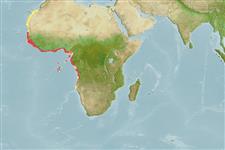Classification / Names
Common names from other countries
Main reference
Size / Weight / Age
Max length : 80.0 cm TL male/unsexed; (Ref. 1371); common length : 40.0 cm TL male/unsexed; (Ref. 26999)
Environment
Marine; bathydemersal; non-migratory; depth range 50 - 1000 m (Ref. 112558), usually 50 - 550 m (Ref. 58452)
Climate / Range
Deep-water, preferred 25°C (Ref. 107945); 29°N - 19°S, 19°W - 15°E (Ref. 58452)
Distribution
Eastern Atlantic: off the coast of tropical West Africa, from Mauritania to Angola. Range reported to extend to off southwest Africa near Cape Frio, Namibia (Ref. 6524).
Countries | FAO areas | Ecosystems | Occurrences | Introductions
Short description
Dorsal
spines
(total): 1;
Dorsal
soft rays
(total): 45-52. Head large and little depressed. Pectoral fin tips usually reaching the origin of anal fin in small but not in large individuals. Scales easily shed. Color usually blackish on back, steel gray to blackish on belly; caudal fin white-edged.
IUCN Red List Status (Ref. 115185)
Threat to humans
Harmless
Human uses
Fisheries: minor commercial
More information
Common namesSynonymsMetabolismPredatorsEcotoxicologyReproductionMaturitySpawningFecundityEggsEgg development
ReferencesAquacultureAquaculture profileStrainsGeneticsAllele frequenciesHeritabilityDiseasesProcessingMass conversion
Tools
Special reports
Download XML
Internet sources
Estimates of some properties based on models
Phylogenetic diversity index
PD50 = 0.5000 many relatives (e.g. carps) 0.5 - 2.0 few relatives (e.g. lungfishes)
Trophic Level
4.5 ±0.63 se; Based on food items.
Resilience
Medium, minimum population doubling time 1.4 - 4.4 years (K=0.39(?); assuming tm>=2)
Vulnerability
Low to moderate vulnerability (35 of 100)
Price category
